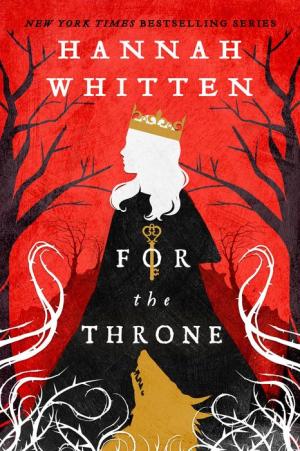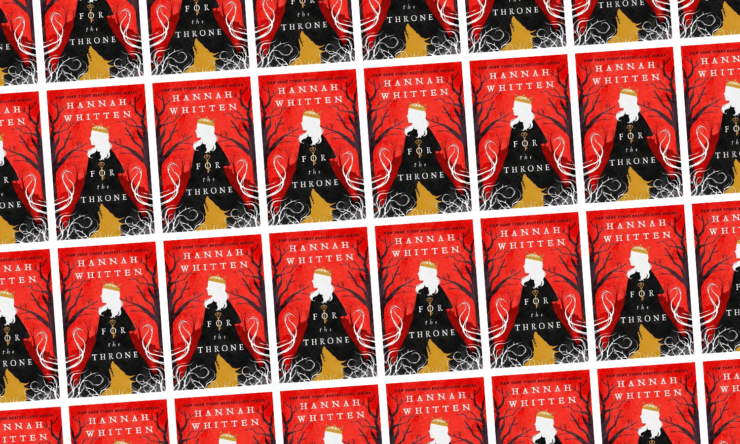Last year, Hannah Whitten made her debut with For the Wolf, a rich and immersive fantasy that twined the familiar threads of fairy tales into the eerie mythology of her fantastical world. Two royal sisters, Red and Neve, had their futures set before they were born. Neve, the elder, would ascend the throne of Valleyda. Red, the younger, would be sacrificed to the Wolf, who lives in the threatening, magical Wilderwood—and who is not at all what he seems.
For the Wolf was largely Red’s book, but Neve’s story was necessary to fully understand Red’s, to get the bigger picture of how Valleydan politics, religion, and lore came to shape the lives of these two young women. In the Wilderwood and at court, they both learned how stories can be twisted to serve the people who tell them—and how something can be true and untrue at the same time.
For the Throne gives Neve center stage, but doesn’t strike such a satisfying balance. While Neve explores the Shadowlands with a brooding companion, Red takes on side quests that don’t feed the narrative in the same vital way. Part of her story is about learning to be patient; part of both their stories are about whether or not you can ever save someone who doesn’t want saving. But the striking resonance of For the Wolf doesn’t quite carry through to Throne.
At the end of For the Wolf, Neve—who made a lot of dicey choices in hopes of saving Red—is sucked into the Shadowlands, a realm of gods and Kings and piles of bone. Her companion there is Solmir, who was once one of the mythic, evil Kings trapped in the Shadowlands but has since turned against his peers. Neve has very good reasons to hate him. Of course she doesn’t—not for long.
Buy the Book


For the Throne
While Whitten mined fairy tales in book one—not just “Little Red Riding Hood” and “Beauty and the Beast,” but a whole host of imagery—here she turns to mythology. The colorless, crumbling Shadowlands are home to Old Ones that are looming distillations of familiar creatures: a Weaver whose lover is part spider, a Leviathan too great to be comprehended by mortal vision; an eerie Oracle who lives in a mountain of bones. Neve’s time in this inverted world brings to mind Persephone in the underworld, complete with the attention of one of its (former) rulers. It’s apparent quite early on that Neve and Solmir are on a path much like the one trod by Red and Eammon, her Wolf. Suspicion, anger, and distrust between the two gradually give way to attraction, understanding, and affection. Each pair faces its own challenges, but the enemies-to-lovers beats are familiar all the same.
In the wake of her choices in the first book, Neve has a lot of questions about who and what she is: Is she a monster? Can she be good? In the grayscale Shadowlands, the difference between good and evil isn’t as simple as some might like it to be. Monstrousness, like beauty, is definitely in the eye of the beholder. Neve never struck me as any kind of monster—prickly, complex, and stubborn, yes, but not monstrous. Her journey to figuring this out for herself is a long one, and one I wish had felt less repetitive—not just in plot, as she and Solmir find and defeat Old Ones, but often in description, in reaction shots, in drawn brows and murmured dialogue and Solmir’s impossible scent of pine and snow.
While Neve and Solmir make their troubled through the Shadowlands, Red waits. She and her somewhat underwritten friends find a clue in the village of Edge, beyond the Wilderwood, and they venture across the sea to where a certain piece-of-work priestess is holed up. But the whole sea trip seems mainly to tie up that loose end, and to uncover the secrets of another secondary character who never quite gets the page time she deserves.
The strongest part of Whitten’s story is the bond between Red and Neve, whose love for each other is more powerful, and more important, than that for their love interests. Red’s willingness to wait, to practice patience, is an elegant mirror to Neve’s impatience last book; Neve’s mistakes include not trusting Red, and Red now has to trust her sister, despite Neve’s history of poor decision-making. The twins are drawn in opposition—black shadows and green vines, dark hair and light, willing sacrifice and resistant heir—and there is satisfaction in seeing them both step free of those roles while setting a new kind of power free in their world as well.
Whitten’s visual imagination remains striking and bold, full of trees and apples and vines and keys, images that are fraught by virtue of their familiarity but neatly used to the author’s own ends. She isn’t just turning fairy tales and myth to her own end, but inventing her own mythology: You can see every pile of bones in the Shadowlands, every point on the crowns of the nasty Kings; you can easily imagine the towering Heart Tree, the inverted palace, just as you could the white sentinel trees of book one, their bloody branches in stark contrast to the green that floods Eammon’s veins. Whitten’s world is vibrant, her sisters complex and captivating. But while Neve and Red work equal magic as each other’s beloved mirrors, For the Throne is a somewhat paler reflection of For the Wolf.
For the Throne is published by Orbit.
Molly Templeton lives and writes in Oregon, and spends as much time as possible in the woods. Sometimes she talks about books on Twitter.










